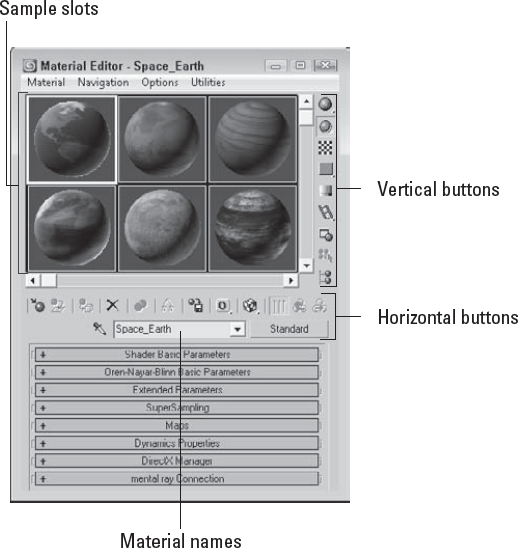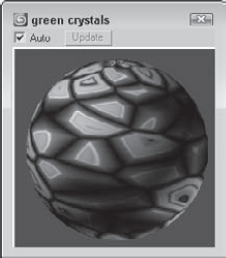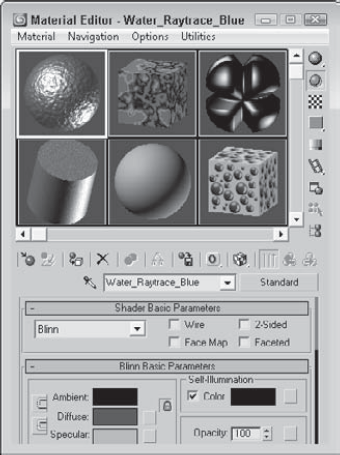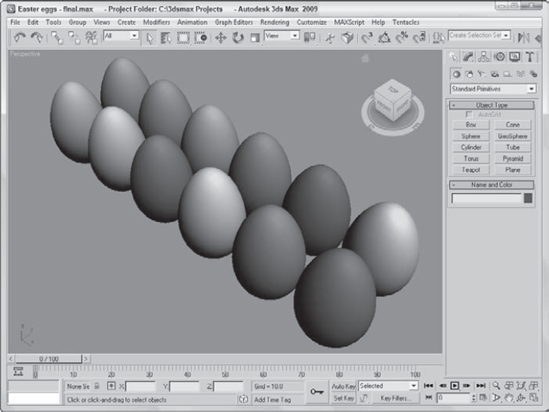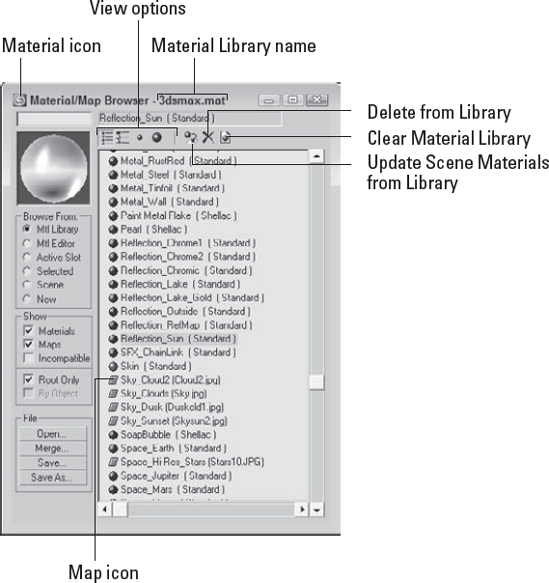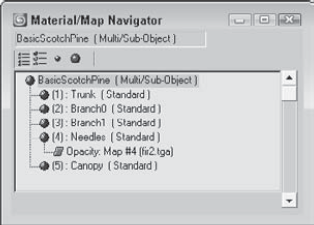Materials are used to dress, color, and paint objects. Just as materials in real life can be described as scaly, soft, smooth, opaque, or blue, materials applied to 3D objects can mimic properties such as color, texture, transparency, shininess, and so on. In this chapter, you learn the basics of working with materials and all the features of the Material Editor.
Before jumping into the Material Editor, let's take a close look at the type of material properties that you will deal with. Understanding these properties will help you as you begin to create new materials.
Up until now, the only material property that has been applied to an object has been the default object color, randomly assigned by Max. The Material Editor can add a whole new level of realism using materials that simulate many different types of physical properties.
Note
Many of these material properties are not visible until the scene is rendered.
Color is probably the simplest material property and the easiest to identify. However, unlike the object color defined in the Create and Modify panels, there isn't a single color swatch that controls an object's color.
Consider a basket of shiny red apples. When you shine a bright blue spotlight on them, all the apples turn purple because the blue highlights from the light mix with the red of the apple's surface. So, even if the apples are assigned a red material, the final color in the image might be very different because the light makes the color change.
Within the Material Editor are several different color swatches that control different aspects of the object's color. The following list describes the types of color swatches that are available for various materials:
Ambient: Defines an overall background lighting that affects all objects in the scene, including the color of the object when it is in the shadows. This color is locked to the Diffuse color by default so that they are changed together.
Diffuse: The surface color of the object in normal, full, white light. The normal color of an object is typically defined by its Diffuse color.
Specular: The color of the highlights where the light is focused on the surface of a shiny material.
Self-Illumination: The color that the object glows from within. This color takes over any shadows on the object.
Filter: The transmitted color caused by light shining through a transparent object.
Reflect: The color reflected by a raytrace material to other objects in the scene.
Luminosity: Causes an object to glow with the defined color. It is similar to Self-Illumination color but can be independent of the Diffuse color.
Note
Standard materials don't have Reflectivity and Luminosity color swatches, but these swatches are part of the Raytrace material.
If you ask someone the color of an object, he or she would respond by identifying the Diffuse color, but all these properties play an important part in bringing a sense of realism to the material. Try applying very different, bright materials to each of these color swatches and notice the results. This gives a sense of the contribution of each color.
Tip
For realistic materials, your choice of colors depends greatly on the scene lights. Indoor lights have a result different from an outdoor light like the sun. You can simulate objects in direct sunlight by giving their Specular color a yellow tint and their Ambient color a complementary, dark, almost black or purple color. For indoor objects, make the Specular color bright white and use an Ambient color that is the same as the Diffuse color, only much darker. Another option is to change the light colors instead of changing the specular colors.
Opaque objects are objects that you cannot see through, such as rocks and trees. Transparent objects, on the other hand, are objects that you can see through, such as glass and clear plastic. Max's materials include several controls for adjusting these properties, including Opacity and several Transparency controls.
Opacity is the amount that an object refuses to allow light to pass through it. It is the opposite of transparency and is typically measured as a percentage. An object with 0 percent opacity is completely transparent, and an object with 100 percent opacity doesn't let any light through.
Transparency is the amount of light that is allowed to pass through an object. Because this is the opposite of opacity, transparency can be defined by the opacity value. Several options enable you to control transparency, including Falloff, Amount, and Type. These options are discussed later in this chapter.
A reflection is what you see when you look in the mirror. Shiny objects reflect their surroundings. By defining a material's reflection values, you can control how much it reflects its surroundings. A mirror, for example, reflects everything, but a rock won't reflect at all.
Reflection Dimming controls how much of the original reflection is lost as the surroundings are reflected within the scene.
Refraction is the bending of light as it moves through a transparent material. The amount of refraction that a material produces is expressed as a value called the Index of Refraction. The Index of Refraction is the amount that light bends as it goes through a transparent object. For example, a diamond bends light more than a glass of water, so it has a higher Index of Refraction value. The default Index of Refraction value is 1.0 for objects that don't bend light at all. Water has a value of 1.3, glass a value of around 1.5, and solid crystal a value of around 2.0.
Shiny objects, such as polished metal or clean windows, include highlights where the lights reflect off their surfaces. These highlights are called specular highlights and are determined by the Specular settings. These settings include Specular Level, Glossiness, and Soften values.
The Specular Level is a setting for the intensity of the highlight. The Glossiness determines the size of the highlight: Higher Glossiness values result in a smaller highlight. The Soften value thins the highlight by lowering its intensity and increasing its size.
A rough material has the opposite properties of a shiny material and almost no highlights. The Roughness property sets how quickly the Diffuse color blends with the Ambient color. Cloth and fabric materials have a high Roughness value; plastic and metal Roughness values are low.
Note
Specularity is one of the most important properties that we sense to determine what kind of material the object is made from. For example, metallic objects have a specular color that is the same as their diffuse color. If the colors are different, then the objects look like plastic instead of metal.
Max uses several miscellaneous properties to help define standard materials, including Diffuse Level and Metalness.
The Diffuse Level property controls the brightness of the Diffuse color. Decreasing this value darkens the material without affecting the specular highlights. The Metalness property controls the metallic look of the material. Some properties are available only for certain material types.
Note
Before proceeding, you need to understand the difference between a material and a map. A material is an effect that permeates the 3D object, but most maps are 2D images (although procedural 3D maps also exist) that can be wrapped on top of the object. Materials can contain maps, and maps can be made up of several materials. In the Material Editor, materials appear shaded in the sample slots, and maps appear as 2D images. Usually, you can tell whether you're working with a material or a map by looking at the default name. Maps show up in the name drop-down list as Map and a number (Map #1), and materials are named a number and Default (7- Default).
The Material Editor is the interface with which you define, create, and apply materials. You can access the Material Editor by choosing Rendering
At the top of the default Material Editor window is a menu of options including Material, Navigation, Options, and Utilities. The menu commands found in these menus offer the same functionality as the toolbar buttons, but the menus are often easier to find than the buttons with which you are unfamiliar.
Below the menus are six sample slots that display a preview of some available materials. Surrounding these slots are button icons for controlling the appearance of these sample slots and interacting with materials. Figure 14.1 shows the Material Editor.
The button icons to the right and below the sample slots control how the materials appear in the editor. These buttons are defined in Tables 14.1 and 14.2.
Table 14.1. Material Editor Buttons—Vertical
Toolbar Button | Name | Description |
|---|---|---|
Sample Type (Sphere, Cylinder, Box, Custom) | Controls the type of object displayed in the sample slot. The default object is a sphere. Other options available as flyouts include a cylinder and a cube. You can also select a custom object to use as the preview object. | |
Backlight (L) | Turns backlighting in the selected sample slot on or off. | |
Background (B) | Displays a checkered background image (or a custom background) behind the material, which is helpful when displaying a transparent material. | |
Sample UV Tiling (1×1, 2 × 2, 3 × 3, 4 × 4) | Sets UV tiling for the map in the sample slot. The default is 1 × 1. Additional options available as flyouts are 2 × 2, 3 × 3, and 4 × 4. This setting affects only maps. | |
Video Color Check | Checks the current material for colors that are unsupported by the NTSC and PAL formats. | |
Make Preview (P), Play Preview, Save Preview | Used to generate, view, and save material preview renderings. These animated material previews enable you to see the effect of an animated material before rendering. | |
Options (O) | Opens the Material Editor Options dialog box. This dialog box includes settings for enabling material animation, loading a custom background, defining the light intensity and color, and specifying the number of sample slots. | |
Select by Material | Selects all objects using the current material. This button opens the Select Objects dialog box with those objects selected. | |
Material/Map Navigator | Opens the Material/Map Navigator dialog box. This dialog box displays a tree of all the levels for the current material. |
Table 14.2. Material Editor Buttons—Horizontal
Name | Description | |
|---|---|---|
Get Material (G) | Opens the Material/Map Browser for selecting materials. | |
Put Material in Scene | Updates the materials applied to objects in the viewport after materials have been edited. | |
Assign Material to Selection | Applies the selected object with the selected material. | |
Reset Map/Mtl to Default Settings | Removes any modified properties and resets the material properties to their defaults. | |
Make Material Copy | Creates a copy of the current material in the selected sample slot. | |
Make Unique | Makes instanced materials into a new stand-alone material. | |
Put to Library | Opens a simple dialog box that lets you rename the material and saves it into the current open library. | |
Material Effects Channel | Sets a unique channel ID for applying post-processing effects. This button includes channels 1@nd15 as flyouts. A material with channel 0 means that no effect will be applied. | |
Show Map in Viewport, Show Hardware Map in Viewport | Displays 2D material maps and hardware maps on objects in the viewports. | |
Show End Result | Displays the material in the sample slot with all levels applied. If this button is disabled, you will see only the level that is currently selected. | |
Go to Parent | Moves up one level for the current material. This applies only to compound objects with several levels. | |
Go Forward to Sibling | Selects the next map or material at the same level. | |
Pick Material From Object | Enables you to select a material from an object in the scene and load the material into the selected sample slot. | |
Material drop-down list | Lists the elements in the current material. You can change the material or map name by typing a new name in this field. | |
Type button | Displays the current material or map type that is being used. Clicking this button opens the Material/Map Browser where you can select a new material or map type. |
Below the material name and type button is where the rollouts for the current material are opened. These rollouts change depending on the material type.
Note
The Material Effects Channel IDs are used with the Rendering Effects dialog box to apply specific effects, such as glow and blur, to a material. To learn more about these effects, see Chapter 45, "Using Atmospheric and Render Effects."
The Material Editor includes 24 sample slots that display materials and map examples. Each of these sample slots contains one material or map. Only one sample slot can be selected at a time: The selected slot is outlined with a white border. Click one of the material slots to select it.
Note
Sample slots cannot be empty: They always contain some kind of material.
Sample slots are temporary placeholders for materials and maps. An actual scene can have hundreds of materials. By loading a material into a sample slot, you can change its parameters, apply it to other objects, or save it to a library for use in other scenes. When a file is saved, all materials in the Material Editor are saved with the file.
Twenty-four slots are available, but the default layout displays only six. You can access the other 18 slots using the scroll bars. You can also change the number of displayed slots. To change the number of slots, choose Options
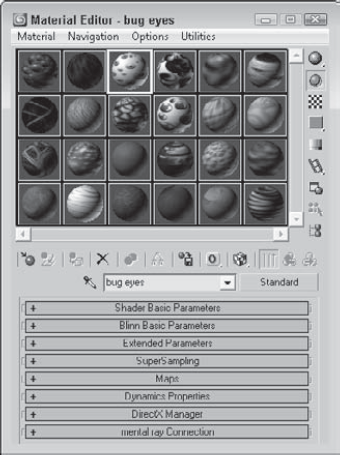
Figure 14.2. You can set the number of sample slots in the Material Editor to display 6, 15, or 24 slots.
Note
The 24 default sample slots that are by default a dull gray are loaded from the medit.mat file in the matlibs subdirectory. To load your own custom default materials, save them into this file.
The Material
You can change the Sample Type object displayed in the sample slots to be a sphere, cylinder, or box using the Sample Type button at the top right of the Material Editor window.
The Options button (the seventh button from the top in the vertical column of buttons at the right) opens the Material Editor Options dialog box (also opened with the keyboard shortcut, O), where you can designate a custom sample object. The sample object must be contained in a .max file. To create a sample object, create and save a Max scene with a single object that fits inside a 100-unit cube.
The scene can also include custom lights and cameras. The object must have Mapping Coordinates enabled. You can enable them by selecting the Generate Mapping Coordinates option for primitive objects or by applying the UVW Map modifier. To make the object available, click the File Name button and select the option to Load Camera and/or Lights in the Material Editor Options dialog box. After the object loads, its name appears on the button in the Options dialog box. You can then select the custom object from the Object Type flyout button. Figure 14.4 shows the Material Editor with several different object types loaded, including a custom object.
When you right-click the active sample slot, a pop-up menu appears. From this menu, you can select several commands. The Drag/Copy command is a toggle setting. This option also lets you drag and drop materials between the various sample slots. When the Drag/Copy option is enabled, it leaves a copy of the material when it's dragged to another slot. This option also allows you to drag a material to an object in the viewports. Dropping a material onto an object automatically assigns the material to that object.
The Drag/Rotate pop-up menu command (also found in the Options menu) lets you rotate the material object in the sample slot when you drag with the mouse. Dragging on the object rotates it about its X-axis and Y-axis, and dragging from the corner of the sample slot rotates it about its Z-axis. This feature is useful for looking at how maps are applied. Holding down the Shift key constrains the rotation about a single axis. The Material
You can also drag materials from the sample slots back and forth among the Material/Map Browser, the Asset Browser Utility, and any rollouts where you can specify maps, such as the Environment Map button (found in the Environment dialog box, accessed via Rendering
Every material has a name that appears beneath the sample slots in a drop-down list. This same name appears in the Material Editor's title bar. You can rename a material by typing a new name in the material name drop-down list. This name appears in the Material/Map Navigator dialog box and in the Track View. As you create materials, give each one a unique name that is easy to identify. When a material is saved to a Library with the Put to Library button, a dialog box opens that enables you to rename the material. You can see the name of any of the materials in the sample slots by moving the mouse over the top of the sample slot; the material name appears as a tooltip.
Note
If you drag a material from one sample slot to another, a copy is made with the same name as the original. If one of these materials is changed and then applied to the scene, a warning dialog box appears, stating that a material with the same name already exists in the scene. It also gives you the option of replacing or renaming the material.
You load new materials into the sample slots by clicking the Get Material button (the leftmost button on the horizontal toolbar), choosing the Material
Warning
The Material/Map Browser holds materials and maps. If you select a material map, a 2D map is loaded into the sample slot. 2D maps cannot be applied directly to an object in the viewport. You can tell the difference between maps and materials because maps are flat 2D bitmaps and materials are shown on an object like a sphere.
When you select a material, you can apply it to the selected object in the viewports with the Assign Material to Selection button (the third button from the left on the horizontal toolbar under the sample slots) or with the Material
When you assign a material to an object in the scene, the material becomes "Hot." A Hot material is automatically updated in the scene when the material parameters change. Hot materials have white corner brackets displayed around their sample slots. You can "cool" a material by clicking the Copy Material button (the fifth from the left) or choosing Material
Whenever a material is applied to an object in the scene, the material is added to a special library of materials that get saved with the scene. Materials do not need to be loaded in one of the sample slots to be in the scene library. You can also load materials into the scene library that aren't applied to an object using the Put Material to Scene button (the second button from the left) or the Material
In addition to the scene library, you can also put materials into a separate material library. The Put to Library button (the seventh from the left) or the Material
Another useful option is obtaining a material from an object in the scene. Clicking the eyedropper button to the left of the Material Name or choosing the Material
If you want to select all the objects in your scene with a specific material applied (like the shiny gold material), then select the material in the sample slots and click on the Select by Material button in the vertical set of buttons, or choose the Utilities
The Material
Note
Animated materials are covered in Chapter 20, "Understanding Animation and Keyframe Basics."
After you create a material preview, you can view the preview with the Material
The Utilities
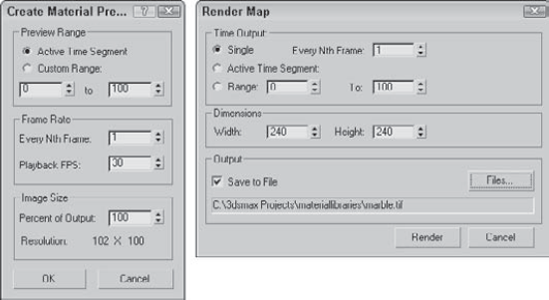
Figure 14.5. The Create Material Preview and Render Map dialog boxes offer two ways to render a material.
Note
You can save render maps as .AVI, .BMP, .CIN, .EPS, .FLC, .HDR, .JPEG, .PNG, .MOV, .SGI, .RGB, .RLA, .RPF, .TGA, .jpg, and .DDS files.
You open the Material Editor Options dialog box by clicking the Options button to the right of the sample slots, selecting Options from the Options menu, right-clicking the pop-up menu, or by just pressing the O key. Figure 14.6 shows this dialog box.
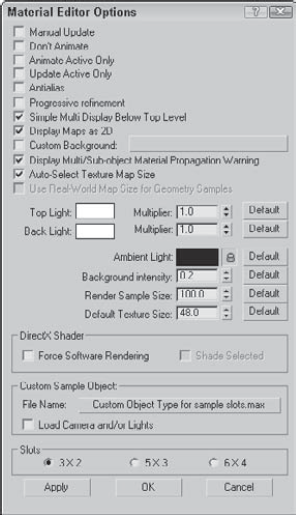
Figure 14.6. The Material Editor Options dialog box offers many options for controlling the Material Editor window.
The Material Editor Options dialog box includes options that control how the materials are displayed in the sample slots. These options are as follows:
Manual Update: Doesn't update any changes in the sample slot until the slot is clicked on.
Don't Animate: Causes materials not to animate when an animation is played or the Time Slider is dragged. It does, however, update these materials to the current frame.
Animate Active Only: Animates only the active sample slot if it contains an animated material. This option isn't available when the Don't Animate option is selected.
Update Active Only: Updates only the active sample slot when changes are made to the material.
Antialias: Enables anti-aliasing for all sample slots. Aliasing is a negative staircase-type effect that occurs for pixel-based images when adjacent pixels along the edges of an image are different colors. Anti-aliasing is a process for eliminating this distracting effect and smoothing the edges.
Progressive refinement: Causes materials to be rendered progressively. This causes the material to appear quickly as blocky sections and then slowly in more detail. This gives you a rough idea of how the material looks before the rendering is finished.
Simple Multi Display Below Top Level: Displays several different areas for only the top level when a Multi/Sub-Object material is applied.
Display Maps as 2D: Displays stand-alone maps in 2D and not on the sample object. This feature helps you to know when you're looking at a map versus a material.
Custom Background: Enables you to use a custom background behind the sample slots. You can load the background using the button to the right of the option. Once changed, the new background is used in all sample slots where the background is enabled.
Display Multi/Sub-object Material Propagation Warning: Lets you to disable the warning screen that appears when you apply a Multi/Sub-object Material to an instanced object.
Auto-Select Texture Map Size: Automatically scales Real-World textures on the sample sphere so that they appear correctly.
Use Real-World Map Size for Geometry Samples: Causes all textures displayed within the sample slots to use Real-World mapping coordinates. This option is available when the Auto-Select Texture Map Size option is disabled.
This dialog box also offers options to adjust the color and intensity of the Top and Backlights used to render the materials in the sample slots. The intensity of these lights is determined by the Multiplier values. You use the Ambient Light Intensity value to control the brightness of the Ambient light in the sample slots; use the lock icon to set the color to the same as the Diffuse color. The Background Intensity value sets the brightness of the background: A value of 0 produces a black background, and 1 produces a white background. The Render Sample Size option scales the maps applied to the sample object for all slots. By scaling the map, you can match it up with the scale of an object in the scene. The Render Sample Size value lets you define the size of the sample slot object using the default units. Changing this value doesn't change the object size in the sample slots, but is used as a reference to the texture size. The Default Texture Size value sets the initial size of Real-World textures. This value applies only to Real-World textures and is ignored by textures using other mapping methods. You can reset all these options to their default values using the Default buttons on the right.
The Custom Sample Object button is for loading a custom sample object (as discussed earlier). The Slots option is used to specify the number of sample slots.
The Reset Material/Maps to Default Settings button (the fourth from the left) lets you reset the selected material to its default settings. If you apply the selected material to a material in the scene, then a dialog box appears that lets you reset just the sample slots or both the sample slots and the material applied to objects in the scene.
The Utilities
If you accidentally apply an unwanted material to an object, you can replace the material with another material by dragging the new material onto the object. If you want to view the object color within the viewport, then open the Display panel, and in the Display Color rollout, select the Object color option for Wireframe and Shaded. The Material Color options display the material color in the viewports.
If you apply a material or map to an object that doesn't look just right and tweaking it won't help, you can always return to square one by removing the material or any mappings that have been applied to the object. The tool to remove materials and maps is the UVW Remove utility. You can access this utility by clicking the More button in the Utility panel and selecting UVW Remove from the list of utilities.
This utility includes a single rollout that lists the number of objects selected. It also includes two buttons. The UVW button removes any mapping coordinates from the selected objects, and the Materials button removes any materials from the selected objects. This button restores the original object color to the selected objects. Alternatively, you can select the Set Gray option, which makes the selected object gray when the materials are removed.
Standard material types always have their Ambient and Diffuse colors locked together. If you have older files with unlocked Diffuse and Ambient colors, the Fix Ambient utility can be used to locate and fix all materials in the scene with this condition. To access this utility, open the Utilities panel, click the More button, and select the Fix Ambient utility. Clicking the Find All button opens a dialog box that lists all materials in the scene with unlocked Diffuse and Ambient colors.
Everyone loves spring with its bright colors and newness of life. One of the highlights of the season is the tradition of coloring Easter eggs. In this tutorial, you use virtual eggs—no messy dyes and no egg salad sandwiches for the next two weeks.
To create your virtual Easter eggs and apply different colors to them, follow these steps:
Open the Easter eggs.max file from the Chap 14 directory on the DVD.
This file contains several egg-shaped objects.
Open the Material Editor by choosing Rendering

Increase the number of sample slots by right-clicking the active material and selecting 5 × 3 Sample Windows from the pop-up menu (or press the X key).
Select the first sample slot, and click the Diffuse color swatch in the rollout below it. From the Color Selector that appears, drag the cursor around the color palette until you find the color you want and then click Close.
In any viewport, select an egg and then click the Assign Material to Selection button in the Material Editor, or you can simply drag the material from its sample slot to the viewport object.
Repeat Steps 4 and 5 for all the eggs.
Figure 14.7 shows the assortment of eggs that we just created.
Now that you know how to apply materials to objects, the easiest way to get materials is from the Material/Map Browser. Max ships with several libraries of materials that you can access. If you click the Get Material button (or press the G key), the Material/Map Browser, shown in Figure 14.8, appears.
The Material/Map Browser is the place where all your materials are stored. They are stored in sets called libraries. These libraries are saved along with the scene file or they can be saved as a separate file. The Material/Map Browser opens whenever you change material types (by clicking on the material type button), choose a new map, or click the Get Material button. Materials are indicated with a blue sphere icon, and material maps have a green parallelogram next to them. Mental ray materials and maps are indicated in yellow, a red sphere appears for materials that have the Show Map in Viewport option enabled, and DirectX Shaders are shown in magenta.
The Material/Map Browser includes several browse options accessible as radio buttons on the left of the dialog box. The browse options include Material Library, Material Editor, Active Slot, Selected, Scene, and New. The Material Library options list all the materials available in the open material library. The current library set is listed in the title bar of the Material/Map Browser. The Material Editor options lists the 24 materials found in the current sample slots. The Active Slot option lists the single material found in the selected sample slot. The Selected and Scene options list the materials applied to the selected viewport objects or all the materials found in the current scene. The New option is the default and lists all the available material types and maps.
You can also limit the material list to show only materials, only maps, or both. The Incompatible option displays all materials and maps that will not work with the current assigned renderer. For example, the mental ray materials are not compatible with the default Scanline renderer. Incompatible materials and maps appear in gray. You can also specify to see all the pieces that make up a material or only the base material with the Root Only option.
Note
All instanced materials are listed in bold within the Material/Map Browser and within the Material/Map Navigator interfaces.
The view options buttons above the material list enable you to display the materials and maps in different ways. They include List, List + Icons, Small Icons, and Large Icons. Figure 14.9 shows two different display methods.
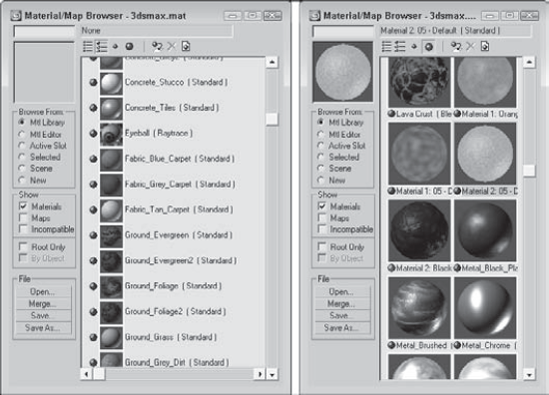
Figure 14.9. You can use the Material/Map Browser to view the materials in many different ways, such as View List + Icons and Large Icons.
The text field directly above the material sample slot in the Material/Map Browser is a selection field. By typing a name in this field, you can search and select materials. Above the material list, three additional buttons become enabled when you open a material library. These buttons let you update the scene, delete the selected material from the library, and clear the entire library.
Anytime you adjust a material or a map parameter, a new material is created and the material's sample slot is updated. Although newly created materials are saved along with the scene file, you can make them available for reuse by including them in a library.
Note
Max ships with several different material libraries, including Backgrounds, Bricks, Concrete, Fabric, Ground, Metal, Nature, RayTraced, ReflectionMaps, Skys, Space, Stones, Wood, and several architecture material sets. You can find all these libraries in the matlibs directory.
You can save new materials to a new library or to the default library. Select the material's sample slot, and click the Put in Library button to open a simple dialog box in which you can name the material and add it to the current library.
To see which library is current, open the Material/Map Browser by clicking the Get Material button. Select the Mtl Library option in the Browse From section: The library name is shown in the title bar. The File section includes four buttons for opening, merging, and saving material libraries. After you've created all the materials you want to keep to a library, the Save button lets you save the library as a file. Material libraries are saved with the .mat extension.
Note
Although materials can be saved out as libraries, perhaps the easiest way to share materials between applications is using the Material XML Export utility. To learn about this utility, see Chapter 3, "Working with Files, Importing, and Exporting."
To practice loading a material library, I've created a custom library of materials using various textures created with Kai's Power Tools.
To load a custom material library, follow these steps:
Choose Rendering

In the Browse From section, select the Mtl Library option and click the Open button.
Select and open the KPT samples.mat file from the Chap 14 directory on the DVD.
The library loads into the Material/Map Browser.
In the selection field (above the sample slot), type Bug to locate and select the bug eyes material.
Figure 14.10 shows the Material/Map Browser with the custom material library open.
Each material can consist of several submaterials. For example, anytime a map is added to a material, it becomes a submaterial. A single material can consist of many submaterials, which may be maps or materials. You can edit each submaterial by accessing the rollouts associated with it. The trick is being able to locate the various submaterials. This is where the Material/Map Navigator comes in handy.
The Material/Map Navigator, shown in Figure 14.11, shows all the submaterials that make up a material in a hierarchy list. It can be accessed by clicking on the bottom-most vertical column on buttons that are to the right of the sample slots. Double-clicking a submaterial opens the submaterial and all of its associated rollouts in the Material Editor.
The Material/Map Navigator, like the Material/Map Browser, offers several viewing methods for the submaterials, including View List, View List + Icons, View Small Icons, and View Large Icons.
When you select a submaterial, its object type is displayed on the Object Type button. Directly above this button are three buttons that become active when you select a submaterial. These buttons, shown in Table 14.3, enable you to navigate the submaterial hierarchy. The rightmost button is Go Forward to Sibling. This moves to the next adjacent submaterial on the same level. The Go to Parent button (the second from the right) selects the submaterial's parent. The Show End Result button is a toggle button that shows the selected submaterial or the resulting material with all submaterials included. These options are also available from the Navigation menu. The keyboard shortcuts for these buttons are the arrow keys—Up arrow for Go to Parent, Right arrow for Go Forward to Sibling, and Left arrow for Go Backward to Sibling.
Table 14.3. Submaterial Navigation Buttons
Button | Description |
|---|---|
Go Forward to Sibling | |
Go to Parent | |
Show End Result |
If the submaterial is itself a material, such as one of the submaterials for the Multi/Sub-object material, then you can separate the submaterial from the base material using the Make Unique button.
Materials can add much to the realism of your models. Learning to use the Material Editor, the Material/Map Browser, and the Material/Map Navigator enables you to work with materials. This chapter covered the following topics:
Understanding various material properties
Working with the Material Editor buttons and sample slots
Using the Material/Map Browser and material libraries
Using the Material/Map Navigator to view submaterials
The next chapter delves more into the topic of material, including the standard material and all its settings.

